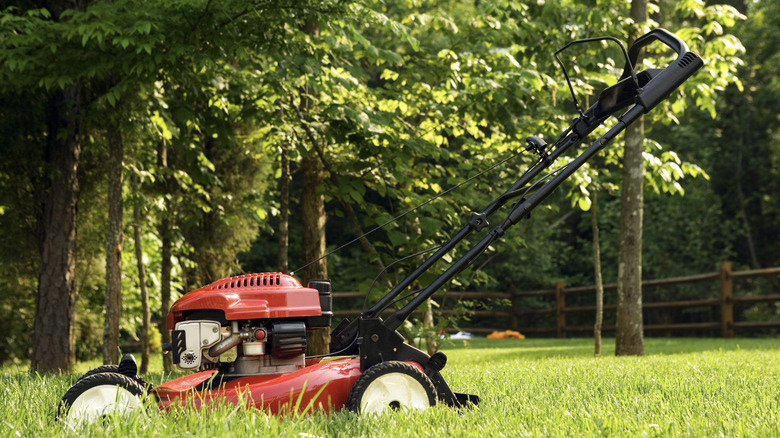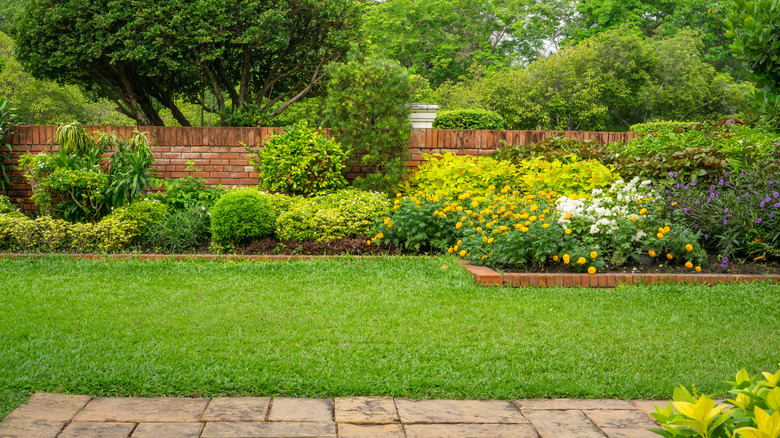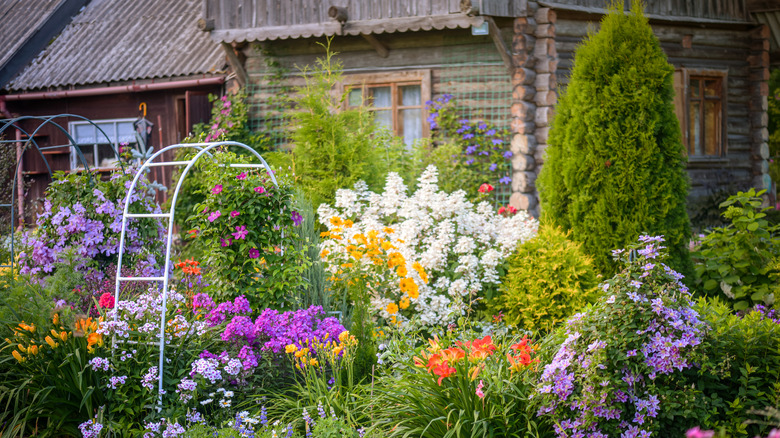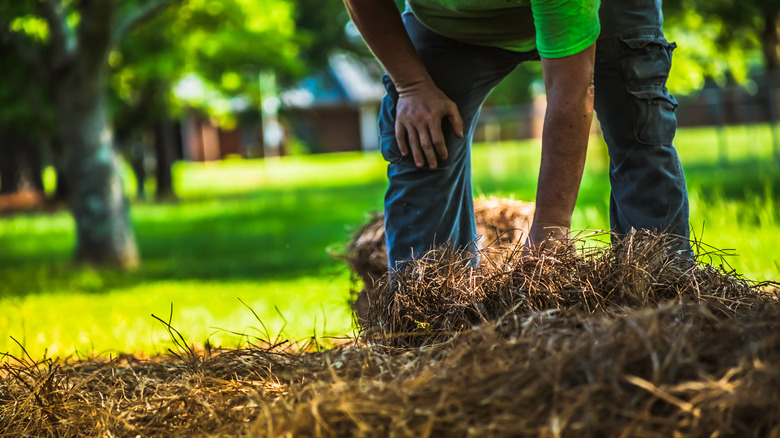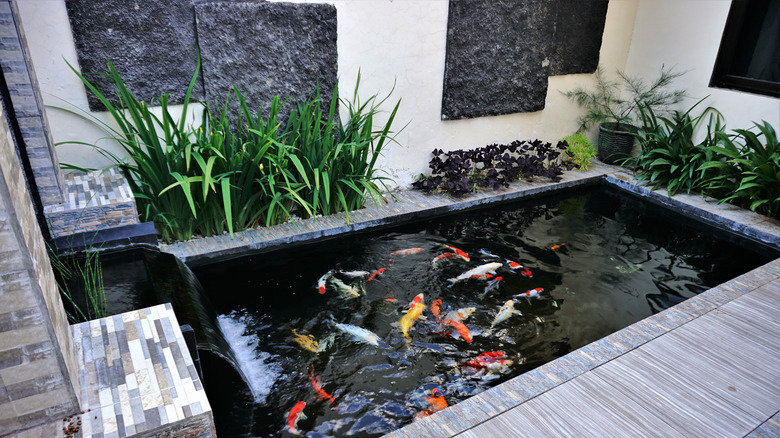Simple Tips To Ensure You're Not Being Overcharged For Lawn Care In 2024
All homeowners have been there — you might need new trees planted, or the holly bushes in your front yard clipped back, or any other small lawn maintenance. It seems like a straightforward task, but there's nothing straightforward about the total printed on your bill. Lawn care costs can vary from under $100 to thousands of dollars depending on the service request, the size of the lawn, its existing condition, and other factors. According to Forbes, landscaping costs are even more expensive, ranging between $2,600 to $13,700.
So, why the hefty price tags? Homeowners take pride in their plots, and a yard is an outward reflection of the home within. Additionally, a beautiful outdoor space raises the likelihood that you'll spend summers grilling out or holidays entertaining friends and family on the patio. According to the U.S. Bureau of Labor Statistics' American Time Use Survey, in 2022 the average American spent over 65 hours working on their lawns throughout the year. Consumers want their yards to look well-kept and beautifully manicured, and landscaping companies know that.
Of course, lawn care is hard work, so you want to ensure you're fairly compensating the team for their hours of manual labor. But you also don't want to get slapped with a bill that's much higher than anticipated, especially when you don't understand all the hidden fees in the invoice. Here are a few tips to ensure that doesn't happen.
Know the basic costs for each type of landscaping project
One of the most basic ways to avoid being overcharged (for anything) is to know the standard industry costs. This will give you a benchmark for reference so that you're able to tell when you think someone might be charging you extra. According to Forbes, you can expect to pay around $10.75 per square foot, or roughly $50 to $100 an hour. Lawn Love estimates that a modest 500-square-foot yard will cost between $2,250 to $8,500, while an expansive 3,000-square-foot space will set you back $13,500 to $51,000. Of course, even if you have a big yard, you don't have to landscape all of it! If you want to save some cash, opt for a few manicured beds and some sod or fence installation while leaving a section to grow wild or tame yourself.
Your landscaping costs will also vary by project, so brush up on the average cost for the work you're getting done. For example, installing a swimming pool in your backyard is a massive project that can cost anywhere from $26,200 to $62,900, while planting new flowers around your front porch will only cost you from $800 to $3,000. A new gazebo is somewhere in the middle at $5,300 to $9,300.
Understand what will cost extra and why
Once you know the basics, you'll need to understand where all those hidden fees in landscaping come from. You might be surprised at some of the factors that can increase the price tag associated with your lawn work, such as soil type. Different pHs influence the kinds of plants that will grow best in your soil. For example, plants like azaleas and rhododendrons flourish in acidic soil, while forsythia and lilac thrive in more alkaline soils. The types of flowers your soil type suits could ultimately affect your project cost.
Additionally, different projects dictate material and shipping costs you might not be aware of. Materials like lumber and marble cost more than traditional concrete, so depending on your budget, you can plan accordingly. Experts also caution that some construction projects require a bit more legwork. Building a fence may necessitate a permit, and while your construction company will handle this for you, you'll still need to pay the fees — which Lawn Love says can run anywhere from $20 to $700.
Lastly, labor fees aren't as straightforward as you think. While landscaping companies generally charge by the hour (remember that $50 to $100 an hour rule of thumb above), skilled labor will cost more than manual labor. There will also be a general upkeep fee, especially when machinery requires extra maintenance.
Avoid being pressured into tipping
When your lawn care bill is higher than you imagined, tipping might feel like a step too far. But just like any good service rendered, you'll want to show your appreciation. The question is, how do you do it without spending too much money? Don't get pressured into shelling out extra cash, but rather, tip strategically.
Say you employ a lawn care service year-round. In this case, your landscaping crew might expect a tip around the holidays. If you don't regularly pay for lawn care, then tipping at the end of your season (whenever that is) makes sense. But if you've just worked with a lawn care company on a one-off basis, a tip isn't necessary — unless you feel like they've really gone above and beyond in their work. Lawn Starter estimates the cost of a holiday tip is from $29 to $65, while the average tip for a one-off job is $7.
Your landscapers certainly don't expect you to tip them every week and shouldn't be asking you for cash on the side. But be conscious about the work they're doing. If you ask them to do something outside of the norm — like pruning your rose bushes or dealing with stray tree benches — experts agree that you should reward them for their efforts. Just $10 or $20 should do the trick!
Remodel your yard the smart way
Lawn care costs add up over time, but even if you're regularly working with a landscaping company, there are still ways to save money. Seek the help of skilled laborers who can do the projects you can't, while saving your money on the landscaping things you know you can do, like mulching or planting. Another pro tip: If your project requires expensive machinery, check to see whether renting machines is an option. In some cases, this might be cheaper — just make sure you can operate them effectively.
Another, fun way to save money on landscaping is by getting thrifty. Pick up your plants during off-season (like late summer) when plant nurseries are holding clearance sales. And while you're choosing your flowers, consider which breeds are drought tolerant. For example, lavender, aster, and black-eyed Susans are all hardy breeds that don't require much water, keeping you from spending money on sprinklers.
Lastly, get crafty with some low-maintenance landscaping ideas. Something like creating your own house number sign is a small project that's proven to create curbside appeal. Or if you're feeling confident, you can tackle a bigger DIY project like installing your own backyard pond. If you go this route, keep it stocked with small minnows or bluegills, which will prevent mosquitoes and gnats from congregating. Whatever project(s) you land on, keeping yourself educated and aware of the industry standards in landscaping will prevent you from being overcharged in the long run.

